University Name: Instacart Case Study - IS Strategy Management
VerifiedAdded on 2022/09/16
|10
|1984
|19
Report
AI Summary
This report provides a comprehensive analysis of Instacart, an online grocery delivery service. It begins with a brief introduction to the company, highlighting its innovative approach to the online grocery market. The report then delves into a detailed analysis of Instacart's value chain, examining its inbound logistics, operations, outbound logistics, marketing and sales, and services, along with support activities like procurement, human resource management, technology development, and firm infrastructure. Furthermore, it applies Porter's five forces model to assess the competitive landscape, evaluating supplier power, buyer power, the threat of new entrants, the threat of substitutes, and competitive rivalry. The report explains Instacart's business model, including its revenue generation methods through markup on prices, delivery fees, and membership fees. It emphasizes the critical role of information technology in fostering innovation, enhancing operational efficiency, and improving customer service. Finally, the report assesses the viability of Instacart's model for selling online groceries, considering its clearly defined product, scalability, and market demand.
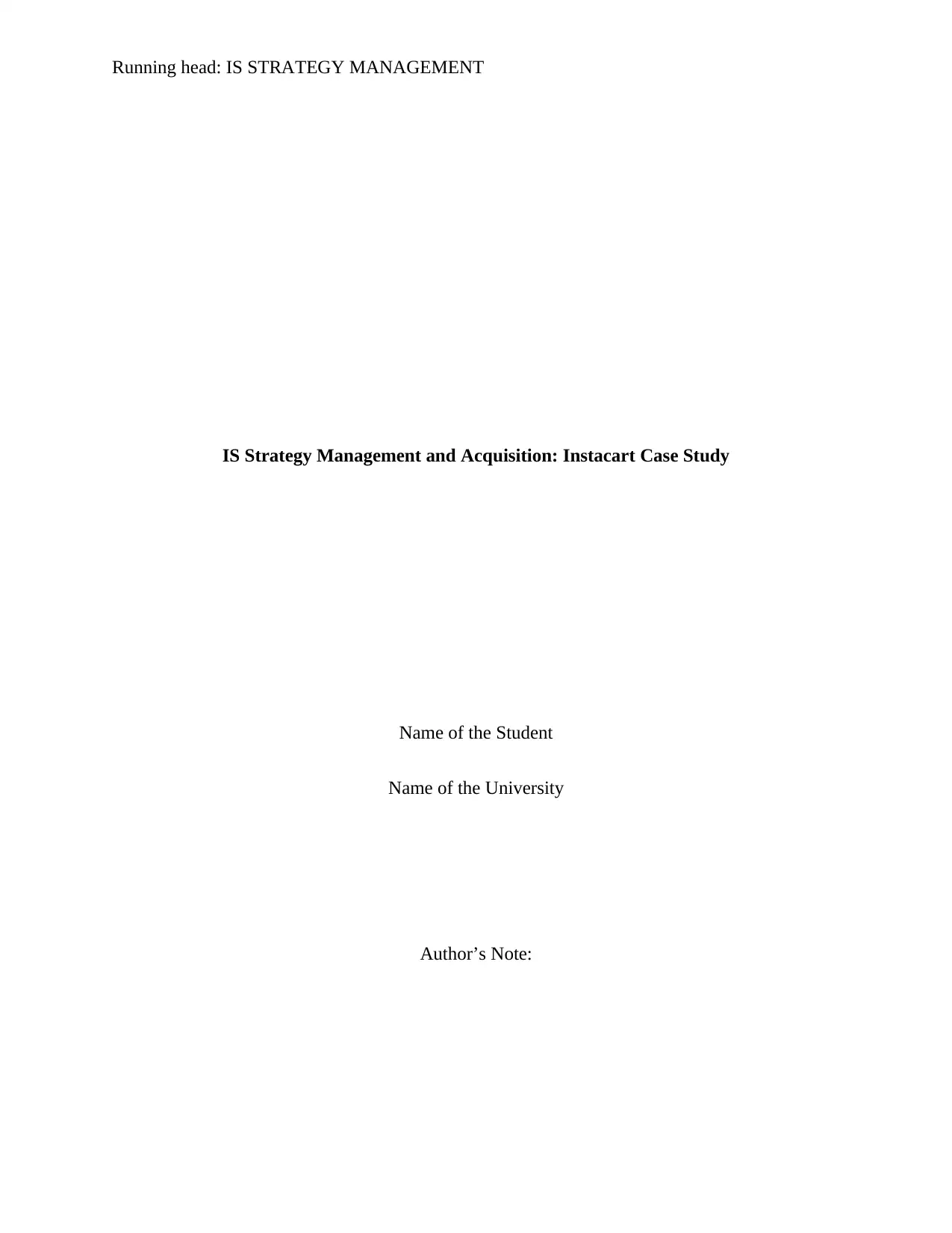
Running head: IS STRATEGY MANAGEMENT
IS Strategy Management and Acquisition: Instacart Case Study
Name of the Student
Name of the University
Author’s Note:
IS Strategy Management and Acquisition: Instacart Case Study
Name of the Student
Name of the University
Author’s Note:
Paraphrase This Document
Need a fresh take? Get an instant paraphrase of this document with our AI Paraphraser
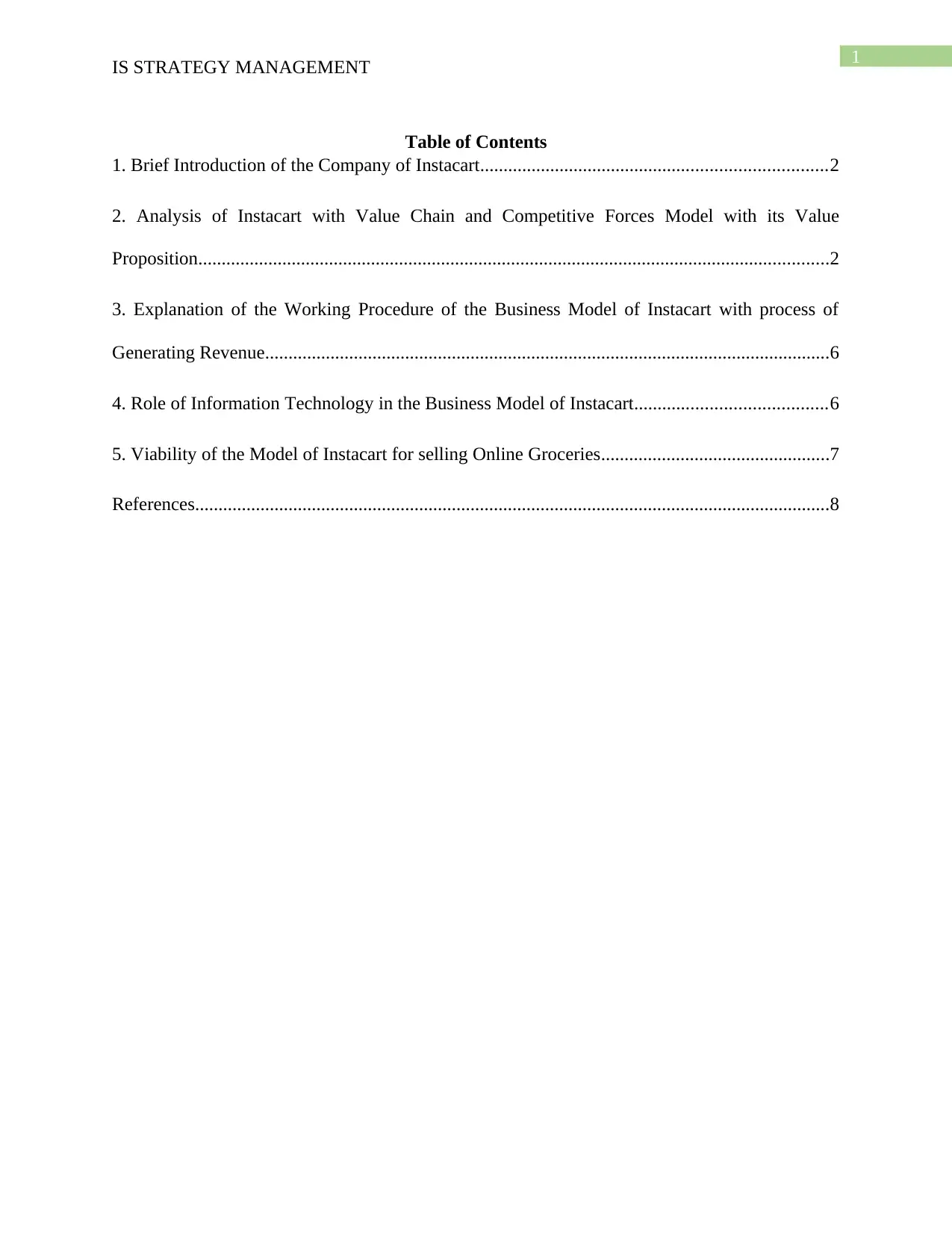
1
IS STRATEGY MANAGEMENT
Table of Contents
1. Brief Introduction of the Company of Instacart..........................................................................2
2. Analysis of Instacart with Value Chain and Competitive Forces Model with its Value
Proposition.......................................................................................................................................2
3. Explanation of the Working Procedure of the Business Model of Instacart with process of
Generating Revenue.........................................................................................................................6
4. Role of Information Technology in the Business Model of Instacart.........................................6
5. Viability of the Model of Instacart for selling Online Groceries.................................................7
References........................................................................................................................................8
IS STRATEGY MANAGEMENT
Table of Contents
1. Brief Introduction of the Company of Instacart..........................................................................2
2. Analysis of Instacart with Value Chain and Competitive Forces Model with its Value
Proposition.......................................................................................................................................2
3. Explanation of the Working Procedure of the Business Model of Instacart with process of
Generating Revenue.........................................................................................................................6
4. Role of Information Technology in the Business Model of Instacart.........................................6
5. Viability of the Model of Instacart for selling Online Groceries.................................................7
References........................................................................................................................................8
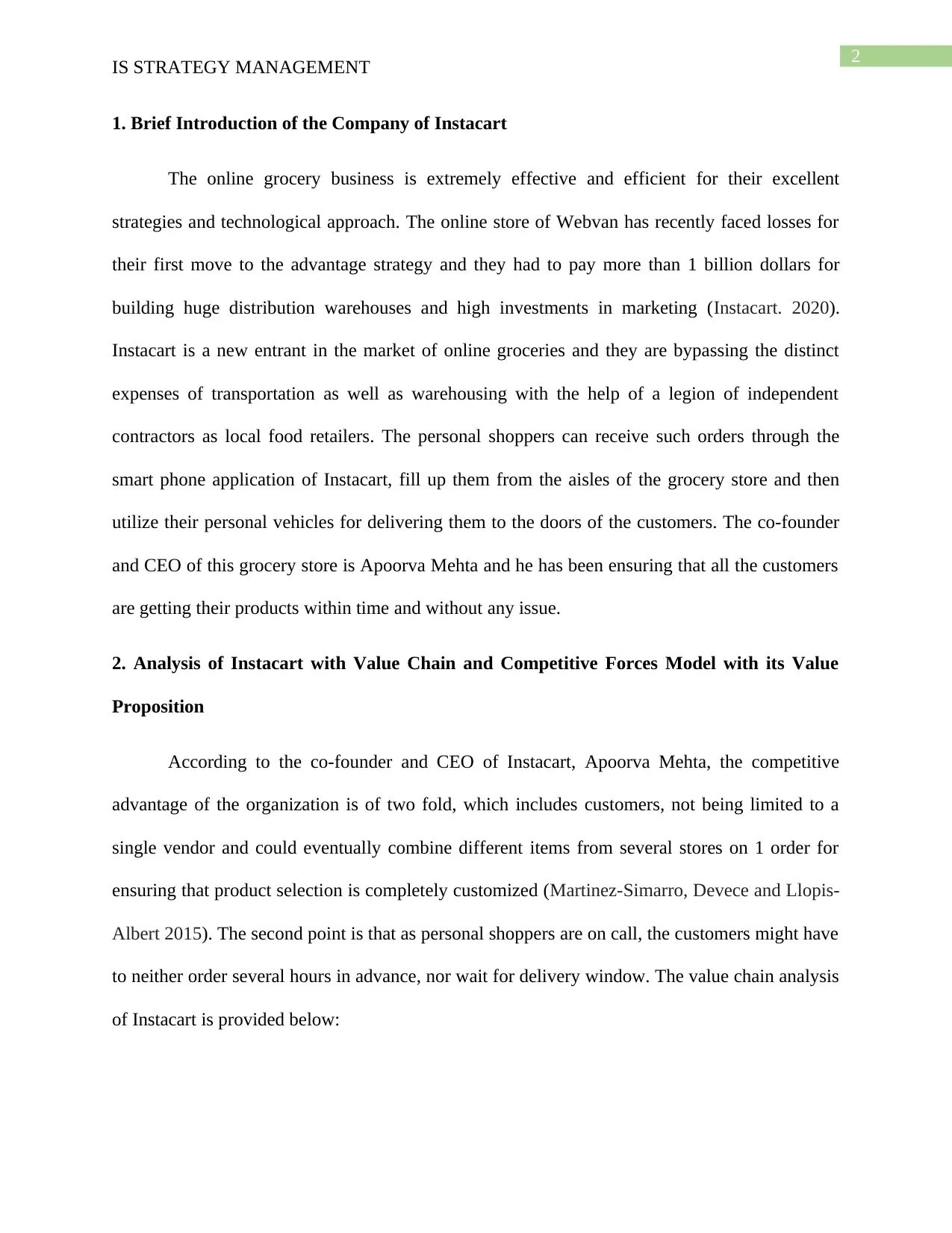
2
IS STRATEGY MANAGEMENT
1. Brief Introduction of the Company of Instacart
The online grocery business is extremely effective and efficient for their excellent
strategies and technological approach. The online store of Webvan has recently faced losses for
their first move to the advantage strategy and they had to pay more than 1 billion dollars for
building huge distribution warehouses and high investments in marketing (Instacart. 2020).
Instacart is a new entrant in the market of online groceries and they are bypassing the distinct
expenses of transportation as well as warehousing with the help of a legion of independent
contractors as local food retailers. The personal shoppers can receive such orders through the
smart phone application of Instacart, fill up them from the aisles of the grocery store and then
utilize their personal vehicles for delivering them to the doors of the customers. The co-founder
and CEO of this grocery store is Apoorva Mehta and he has been ensuring that all the customers
are getting their products within time and without any issue.
2. Analysis of Instacart with Value Chain and Competitive Forces Model with its Value
Proposition
According to the co-founder and CEO of Instacart, Apoorva Mehta, the competitive
advantage of the organization is of two fold, which includes customers, not being limited to a
single vendor and could eventually combine different items from several stores on 1 order for
ensuring that product selection is completely customized (Martinez-Simarro, Devece and Llopis-
Albert 2015). The second point is that as personal shoppers are on call, the customers might have
to neither order several hours in advance, nor wait for delivery window. The value chain analysis
of Instacart is provided below:
IS STRATEGY MANAGEMENT
1. Brief Introduction of the Company of Instacart
The online grocery business is extremely effective and efficient for their excellent
strategies and technological approach. The online store of Webvan has recently faced losses for
their first move to the advantage strategy and they had to pay more than 1 billion dollars for
building huge distribution warehouses and high investments in marketing (Instacart. 2020).
Instacart is a new entrant in the market of online groceries and they are bypassing the distinct
expenses of transportation as well as warehousing with the help of a legion of independent
contractors as local food retailers. The personal shoppers can receive such orders through the
smart phone application of Instacart, fill up them from the aisles of the grocery store and then
utilize their personal vehicles for delivering them to the doors of the customers. The co-founder
and CEO of this grocery store is Apoorva Mehta and he has been ensuring that all the customers
are getting their products within time and without any issue.
2. Analysis of Instacart with Value Chain and Competitive Forces Model with its Value
Proposition
According to the co-founder and CEO of Instacart, Apoorva Mehta, the competitive
advantage of the organization is of two fold, which includes customers, not being limited to a
single vendor and could eventually combine different items from several stores on 1 order for
ensuring that product selection is completely customized (Martinez-Simarro, Devece and Llopis-
Albert 2015). The second point is that as personal shoppers are on call, the customers might have
to neither order several hours in advance, nor wait for delivery window. The value chain analysis
of Instacart is provided below:
⊘ This is a preview!⊘
Do you want full access?
Subscribe today to unlock all pages.

Trusted by 1+ million students worldwide
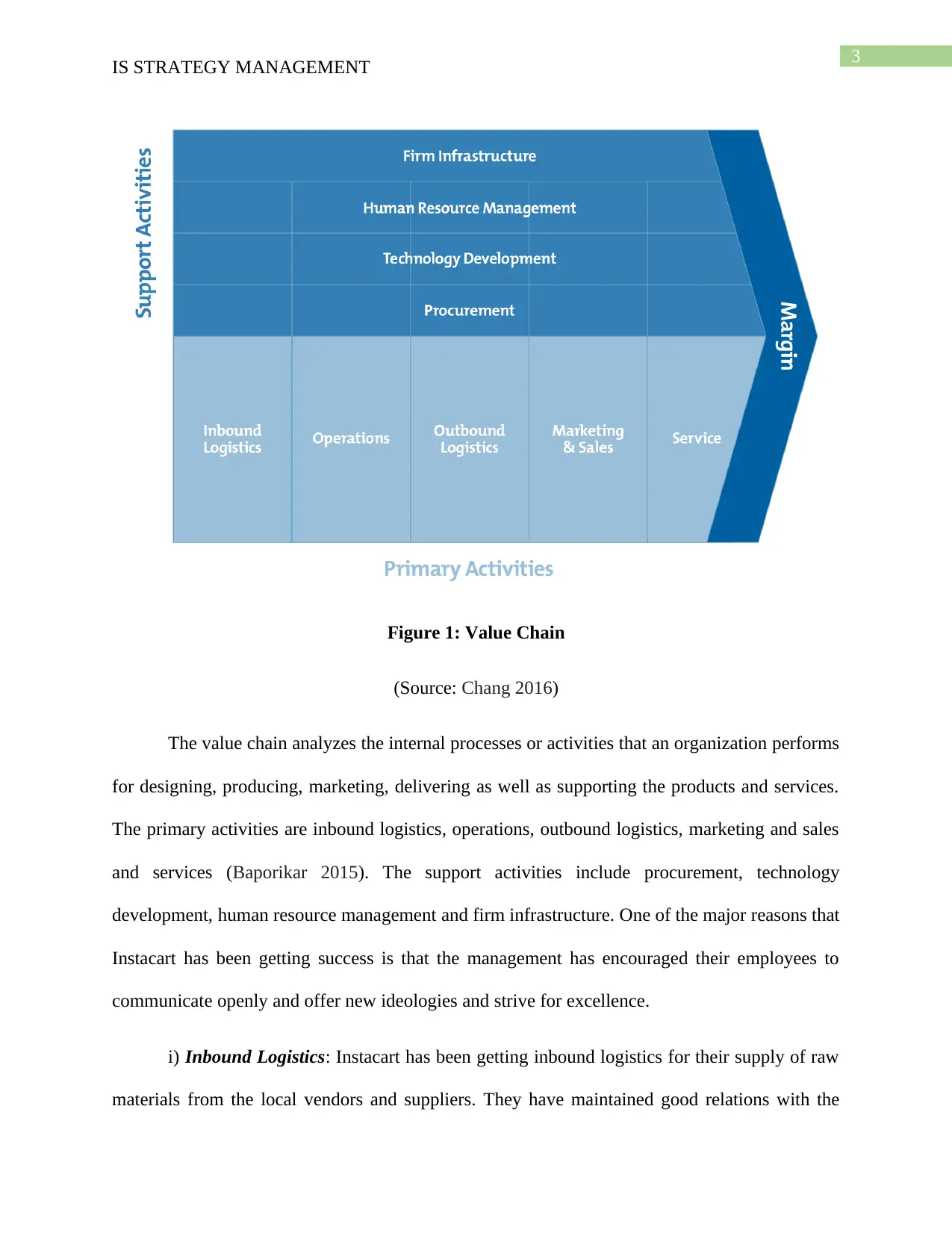
3
IS STRATEGY MANAGEMENT
Figure 1: Value Chain
(Source: Chang 2016)
The value chain analyzes the internal processes or activities that an organization performs
for designing, producing, marketing, delivering as well as supporting the products and services.
The primary activities are inbound logistics, operations, outbound logistics, marketing and sales
and services (Baporikar 2015). The support activities include procurement, technology
development, human resource management and firm infrastructure. One of the major reasons that
Instacart has been getting success is that the management has encouraged their employees to
communicate openly and offer new ideologies and strive for excellence.
i) Inbound Logistics: Instacart has been getting inbound logistics for their supply of raw
materials from the local vendors and suppliers. They have maintained good relations with the
IS STRATEGY MANAGEMENT
Figure 1: Value Chain
(Source: Chang 2016)
The value chain analyzes the internal processes or activities that an organization performs
for designing, producing, marketing, delivering as well as supporting the products and services.
The primary activities are inbound logistics, operations, outbound logistics, marketing and sales
and services (Baporikar 2015). The support activities include procurement, technology
development, human resource management and firm infrastructure. One of the major reasons that
Instacart has been getting success is that the management has encouraged their employees to
communicate openly and offer new ideologies and strive for excellence.
i) Inbound Logistics: Instacart has been getting inbound logistics for their supply of raw
materials from the local vendors and suppliers. They have maintained good relations with the
Paraphrase This Document
Need a fresh take? Get an instant paraphrase of this document with our AI Paraphraser
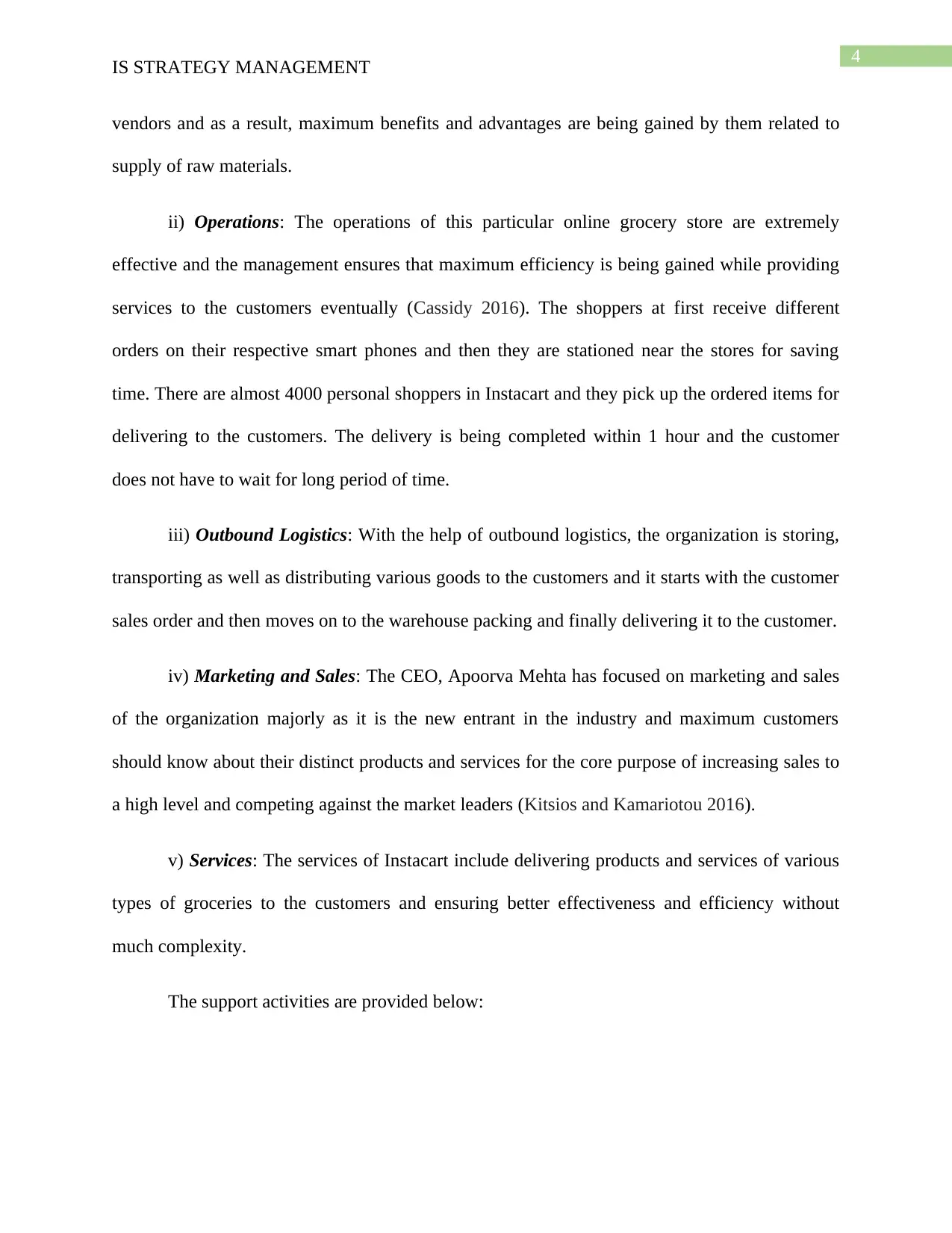
4
IS STRATEGY MANAGEMENT
vendors and as a result, maximum benefits and advantages are being gained by them related to
supply of raw materials.
ii) Operations: The operations of this particular online grocery store are extremely
effective and the management ensures that maximum efficiency is being gained while providing
services to the customers eventually (Cassidy 2016). The shoppers at first receive different
orders on their respective smart phones and then they are stationed near the stores for saving
time. There are almost 4000 personal shoppers in Instacart and they pick up the ordered items for
delivering to the customers. The delivery is being completed within 1 hour and the customer
does not have to wait for long period of time.
iii) Outbound Logistics: With the help of outbound logistics, the organization is storing,
transporting as well as distributing various goods to the customers and it starts with the customer
sales order and then moves on to the warehouse packing and finally delivering it to the customer.
iv) Marketing and Sales: The CEO, Apoorva Mehta has focused on marketing and sales
of the organization majorly as it is the new entrant in the industry and maximum customers
should know about their distinct products and services for the core purpose of increasing sales to
a high level and competing against the market leaders (Kitsios and Kamariotou 2016).
v) Services: The services of Instacart include delivering products and services of various
types of groceries to the customers and ensuring better effectiveness and efficiency without
much complexity.
The support activities are provided below:
IS STRATEGY MANAGEMENT
vendors and as a result, maximum benefits and advantages are being gained by them related to
supply of raw materials.
ii) Operations: The operations of this particular online grocery store are extremely
effective and the management ensures that maximum efficiency is being gained while providing
services to the customers eventually (Cassidy 2016). The shoppers at first receive different
orders on their respective smart phones and then they are stationed near the stores for saving
time. There are almost 4000 personal shoppers in Instacart and they pick up the ordered items for
delivering to the customers. The delivery is being completed within 1 hour and the customer
does not have to wait for long period of time.
iii) Outbound Logistics: With the help of outbound logistics, the organization is storing,
transporting as well as distributing various goods to the customers and it starts with the customer
sales order and then moves on to the warehouse packing and finally delivering it to the customer.
iv) Marketing and Sales: The CEO, Apoorva Mehta has focused on marketing and sales
of the organization majorly as it is the new entrant in the industry and maximum customers
should know about their distinct products and services for the core purpose of increasing sales to
a high level and competing against the market leaders (Kitsios and Kamariotou 2016).
v) Services: The services of Instacart include delivering products and services of various
types of groceries to the customers and ensuring better effectiveness and efficiency without
much complexity.
The support activities are provided below:
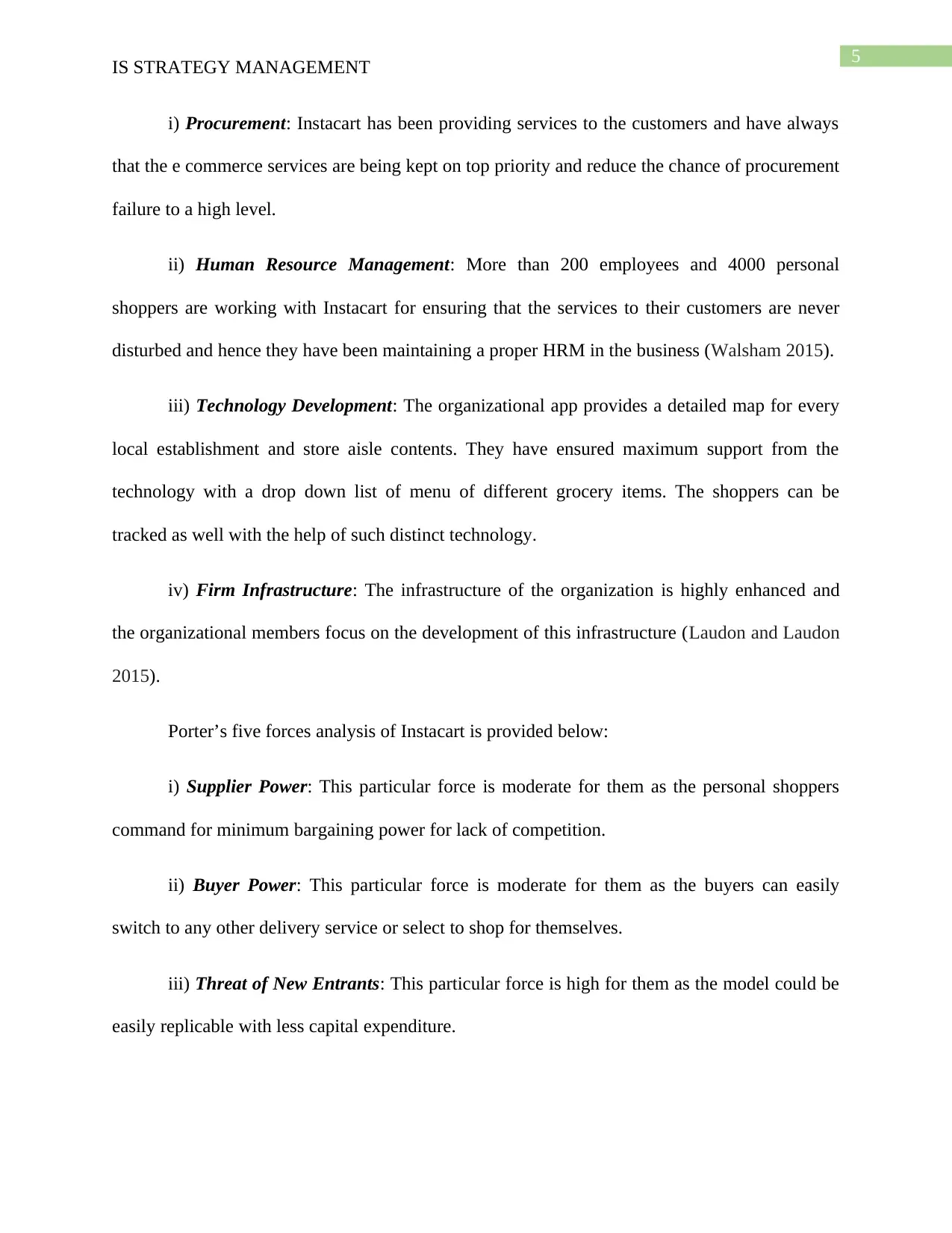
5
IS STRATEGY MANAGEMENT
i) Procurement: Instacart has been providing services to the customers and have always
that the e commerce services are being kept on top priority and reduce the chance of procurement
failure to a high level.
ii) Human Resource Management: More than 200 employees and 4000 personal
shoppers are working with Instacart for ensuring that the services to their customers are never
disturbed and hence they have been maintaining a proper HRM in the business (Walsham 2015).
iii) Technology Development: The organizational app provides a detailed map for every
local establishment and store aisle contents. They have ensured maximum support from the
technology with a drop down list of menu of different grocery items. The shoppers can be
tracked as well with the help of such distinct technology.
iv) Firm Infrastructure: The infrastructure of the organization is highly enhanced and
the organizational members focus on the development of this infrastructure (Laudon and Laudon
2015).
Porter’s five forces analysis of Instacart is provided below:
i) Supplier Power: This particular force is moderate for them as the personal shoppers
command for minimum bargaining power for lack of competition.
ii) Buyer Power: This particular force is moderate for them as the buyers can easily
switch to any other delivery service or select to shop for themselves.
iii) Threat of New Entrants: This particular force is high for them as the model could be
easily replicable with less capital expenditure.
IS STRATEGY MANAGEMENT
i) Procurement: Instacart has been providing services to the customers and have always
that the e commerce services are being kept on top priority and reduce the chance of procurement
failure to a high level.
ii) Human Resource Management: More than 200 employees and 4000 personal
shoppers are working with Instacart for ensuring that the services to their customers are never
disturbed and hence they have been maintaining a proper HRM in the business (Walsham 2015).
iii) Technology Development: The organizational app provides a detailed map for every
local establishment and store aisle contents. They have ensured maximum support from the
technology with a drop down list of menu of different grocery items. The shoppers can be
tracked as well with the help of such distinct technology.
iv) Firm Infrastructure: The infrastructure of the organization is highly enhanced and
the organizational members focus on the development of this infrastructure (Laudon and Laudon
2015).
Porter’s five forces analysis of Instacart is provided below:
i) Supplier Power: This particular force is moderate for them as the personal shoppers
command for minimum bargaining power for lack of competition.
ii) Buyer Power: This particular force is moderate for them as the buyers can easily
switch to any other delivery service or select to shop for themselves.
iii) Threat of New Entrants: This particular force is high for them as the model could be
easily replicable with less capital expenditure.
⊘ This is a preview!⊘
Do you want full access?
Subscribe today to unlock all pages.

Trusted by 1+ million students worldwide
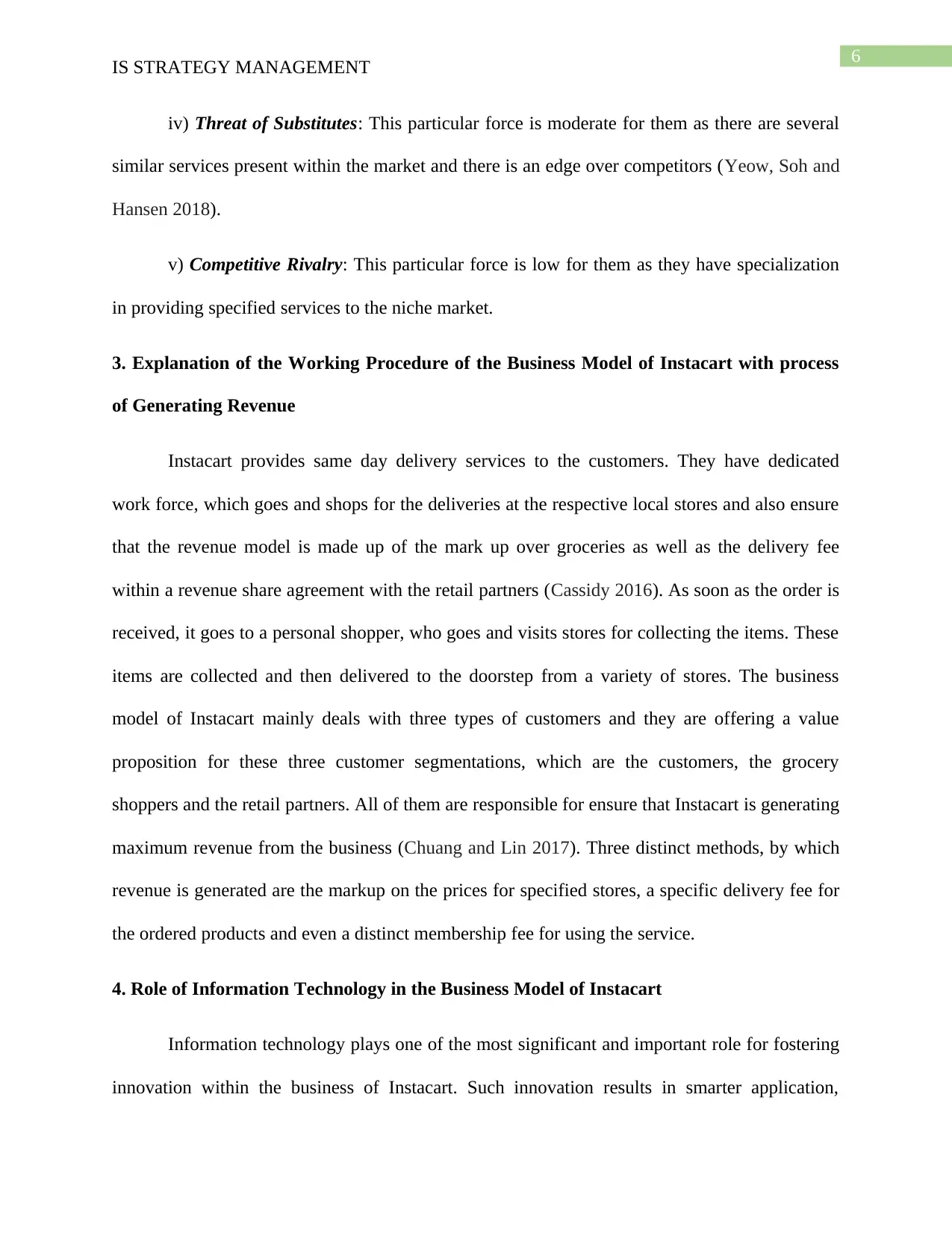
6
IS STRATEGY MANAGEMENT
iv) Threat of Substitutes: This particular force is moderate for them as there are several
similar services present within the market and there is an edge over competitors (Yeow, Soh and
Hansen 2018).
v) Competitive Rivalry: This particular force is low for them as they have specialization
in providing specified services to the niche market.
3. Explanation of the Working Procedure of the Business Model of Instacart with process
of Generating Revenue
Instacart provides same day delivery services to the customers. They have dedicated
work force, which goes and shops for the deliveries at the respective local stores and also ensure
that the revenue model is made up of the mark up over groceries as well as the delivery fee
within a revenue share agreement with the retail partners (Cassidy 2016). As soon as the order is
received, it goes to a personal shopper, who goes and visits stores for collecting the items. These
items are collected and then delivered to the doorstep from a variety of stores. The business
model of Instacart mainly deals with three types of customers and they are offering a value
proposition for these three customer segmentations, which are the customers, the grocery
shoppers and the retail partners. All of them are responsible for ensure that Instacart is generating
maximum revenue from the business (Chuang and Lin 2017). Three distinct methods, by which
revenue is generated are the markup on the prices for specified stores, a specific delivery fee for
the ordered products and even a distinct membership fee for using the service.
4. Role of Information Technology in the Business Model of Instacart
Information technology plays one of the most significant and important role for fostering
innovation within the business of Instacart. Such innovation results in smarter application,
IS STRATEGY MANAGEMENT
iv) Threat of Substitutes: This particular force is moderate for them as there are several
similar services present within the market and there is an edge over competitors (Yeow, Soh and
Hansen 2018).
v) Competitive Rivalry: This particular force is low for them as they have specialization
in providing specified services to the niche market.
3. Explanation of the Working Procedure of the Business Model of Instacart with process
of Generating Revenue
Instacart provides same day delivery services to the customers. They have dedicated
work force, which goes and shops for the deliveries at the respective local stores and also ensure
that the revenue model is made up of the mark up over groceries as well as the delivery fee
within a revenue share agreement with the retail partners (Cassidy 2016). As soon as the order is
received, it goes to a personal shopper, who goes and visits stores for collecting the items. These
items are collected and then delivered to the doorstep from a variety of stores. The business
model of Instacart mainly deals with three types of customers and they are offering a value
proposition for these three customer segmentations, which are the customers, the grocery
shoppers and the retail partners. All of them are responsible for ensure that Instacart is generating
maximum revenue from the business (Chuang and Lin 2017). Three distinct methods, by which
revenue is generated are the markup on the prices for specified stores, a specific delivery fee for
the ordered products and even a distinct membership fee for using the service.
4. Role of Information Technology in the Business Model of Instacart
Information technology plays one of the most significant and important role for fostering
innovation within the business of Instacart. Such innovation results in smarter application,
Paraphrase This Document
Need a fresh take? Get an instant paraphrase of this document with our AI Paraphraser
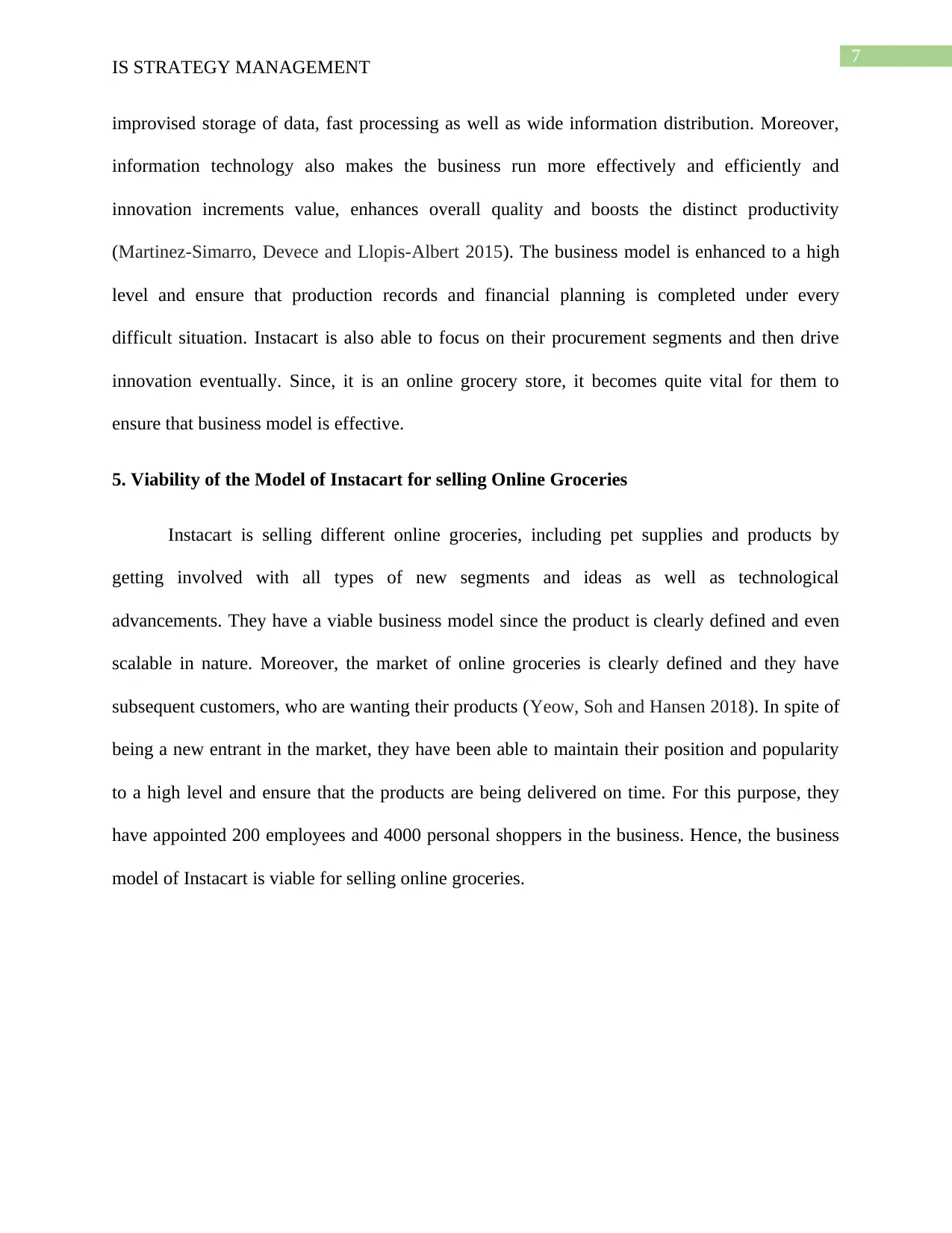
7
IS STRATEGY MANAGEMENT
improvised storage of data, fast processing as well as wide information distribution. Moreover,
information technology also makes the business run more effectively and efficiently and
innovation increments value, enhances overall quality and boosts the distinct productivity
(Martinez-Simarro, Devece and Llopis-Albert 2015). The business model is enhanced to a high
level and ensure that production records and financial planning is completed under every
difficult situation. Instacart is also able to focus on their procurement segments and then drive
innovation eventually. Since, it is an online grocery store, it becomes quite vital for them to
ensure that business model is effective.
5. Viability of the Model of Instacart for selling Online Groceries
Instacart is selling different online groceries, including pet supplies and products by
getting involved with all types of new segments and ideas as well as technological
advancements. They have a viable business model since the product is clearly defined and even
scalable in nature. Moreover, the market of online groceries is clearly defined and they have
subsequent customers, who are wanting their products (Yeow, Soh and Hansen 2018). In spite of
being a new entrant in the market, they have been able to maintain their position and popularity
to a high level and ensure that the products are being delivered on time. For this purpose, they
have appointed 200 employees and 4000 personal shoppers in the business. Hence, the business
model of Instacart is viable for selling online groceries.
IS STRATEGY MANAGEMENT
improvised storage of data, fast processing as well as wide information distribution. Moreover,
information technology also makes the business run more effectively and efficiently and
innovation increments value, enhances overall quality and boosts the distinct productivity
(Martinez-Simarro, Devece and Llopis-Albert 2015). The business model is enhanced to a high
level and ensure that production records and financial planning is completed under every
difficult situation. Instacart is also able to focus on their procurement segments and then drive
innovation eventually. Since, it is an online grocery store, it becomes quite vital for them to
ensure that business model is effective.
5. Viability of the Model of Instacart for selling Online Groceries
Instacart is selling different online groceries, including pet supplies and products by
getting involved with all types of new segments and ideas as well as technological
advancements. They have a viable business model since the product is clearly defined and even
scalable in nature. Moreover, the market of online groceries is clearly defined and they have
subsequent customers, who are wanting their products (Yeow, Soh and Hansen 2018). In spite of
being a new entrant in the market, they have been able to maintain their position and popularity
to a high level and ensure that the products are being delivered on time. For this purpose, they
have appointed 200 employees and 4000 personal shoppers in the business. Hence, the business
model of Instacart is viable for selling online groceries.
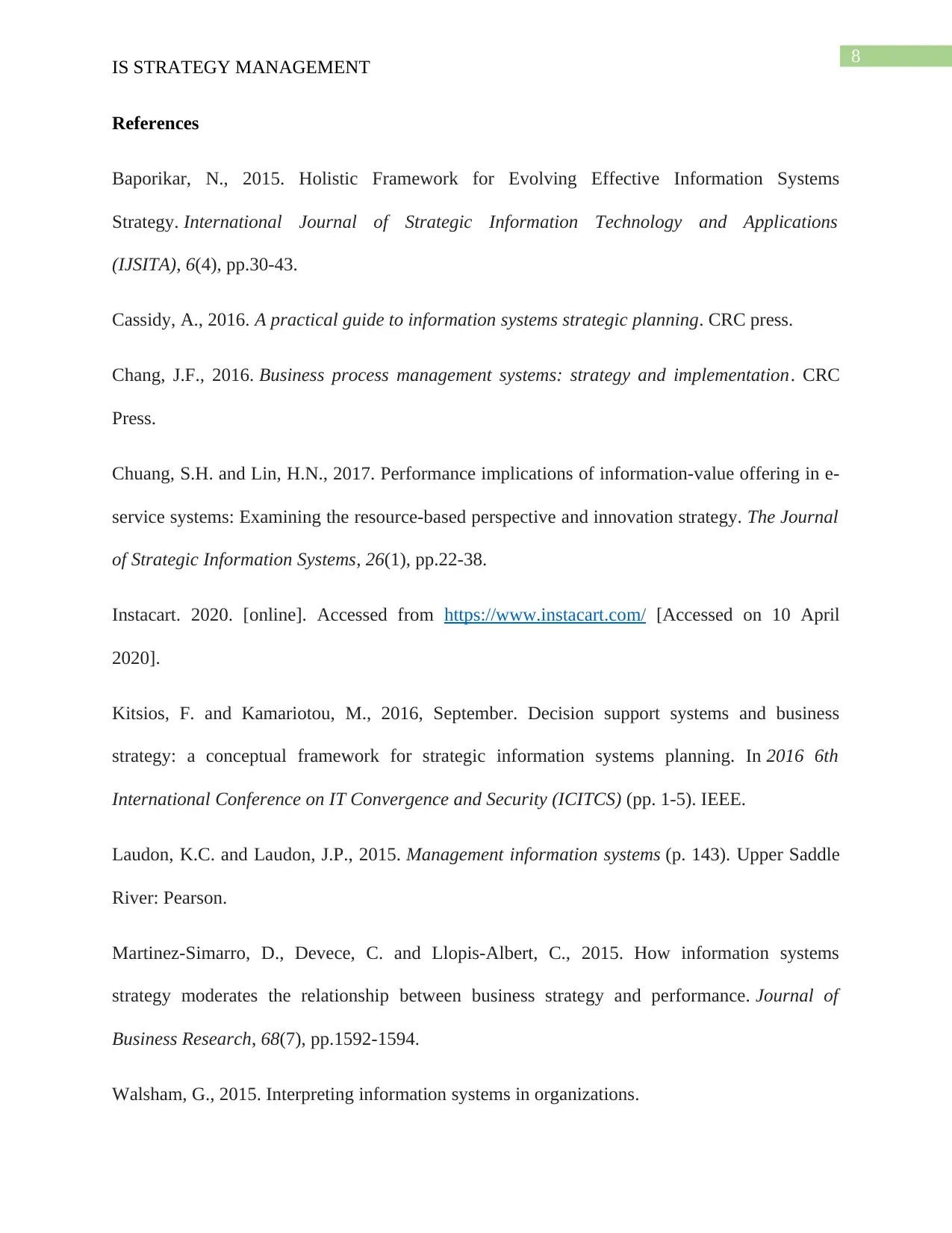
8
IS STRATEGY MANAGEMENT
References
Baporikar, N., 2015. Holistic Framework for Evolving Effective Information Systems
Strategy. International Journal of Strategic Information Technology and Applications
(IJSITA), 6(4), pp.30-43.
Cassidy, A., 2016. A practical guide to information systems strategic planning. CRC press.
Chang, J.F., 2016. Business process management systems: strategy and implementation. CRC
Press.
Chuang, S.H. and Lin, H.N., 2017. Performance implications of information-value offering in e-
service systems: Examining the resource-based perspective and innovation strategy. The Journal
of Strategic Information Systems, 26(1), pp.22-38.
Instacart. 2020. [online]. Accessed from https://www.instacart.com/ [Accessed on 10 April
2020].
Kitsios, F. and Kamariotou, M., 2016, September. Decision support systems and business
strategy: a conceptual framework for strategic information systems planning. In 2016 6th
International Conference on IT Convergence and Security (ICITCS) (pp. 1-5). IEEE.
Laudon, K.C. and Laudon, J.P., 2015. Management information systems (p. 143). Upper Saddle
River: Pearson.
Martinez-Simarro, D., Devece, C. and Llopis-Albert, C., 2015. How information systems
strategy moderates the relationship between business strategy and performance. Journal of
Business Research, 68(7), pp.1592-1594.
Walsham, G., 2015. Interpreting information systems in organizations.
IS STRATEGY MANAGEMENT
References
Baporikar, N., 2015. Holistic Framework for Evolving Effective Information Systems
Strategy. International Journal of Strategic Information Technology and Applications
(IJSITA), 6(4), pp.30-43.
Cassidy, A., 2016. A practical guide to information systems strategic planning. CRC press.
Chang, J.F., 2016. Business process management systems: strategy and implementation. CRC
Press.
Chuang, S.H. and Lin, H.N., 2017. Performance implications of information-value offering in e-
service systems: Examining the resource-based perspective and innovation strategy. The Journal
of Strategic Information Systems, 26(1), pp.22-38.
Instacart. 2020. [online]. Accessed from https://www.instacart.com/ [Accessed on 10 April
2020].
Kitsios, F. and Kamariotou, M., 2016, September. Decision support systems and business
strategy: a conceptual framework for strategic information systems planning. In 2016 6th
International Conference on IT Convergence and Security (ICITCS) (pp. 1-5). IEEE.
Laudon, K.C. and Laudon, J.P., 2015. Management information systems (p. 143). Upper Saddle
River: Pearson.
Martinez-Simarro, D., Devece, C. and Llopis-Albert, C., 2015. How information systems
strategy moderates the relationship between business strategy and performance. Journal of
Business Research, 68(7), pp.1592-1594.
Walsham, G., 2015. Interpreting information systems in organizations.
⊘ This is a preview!⊘
Do you want full access?
Subscribe today to unlock all pages.

Trusted by 1+ million students worldwide
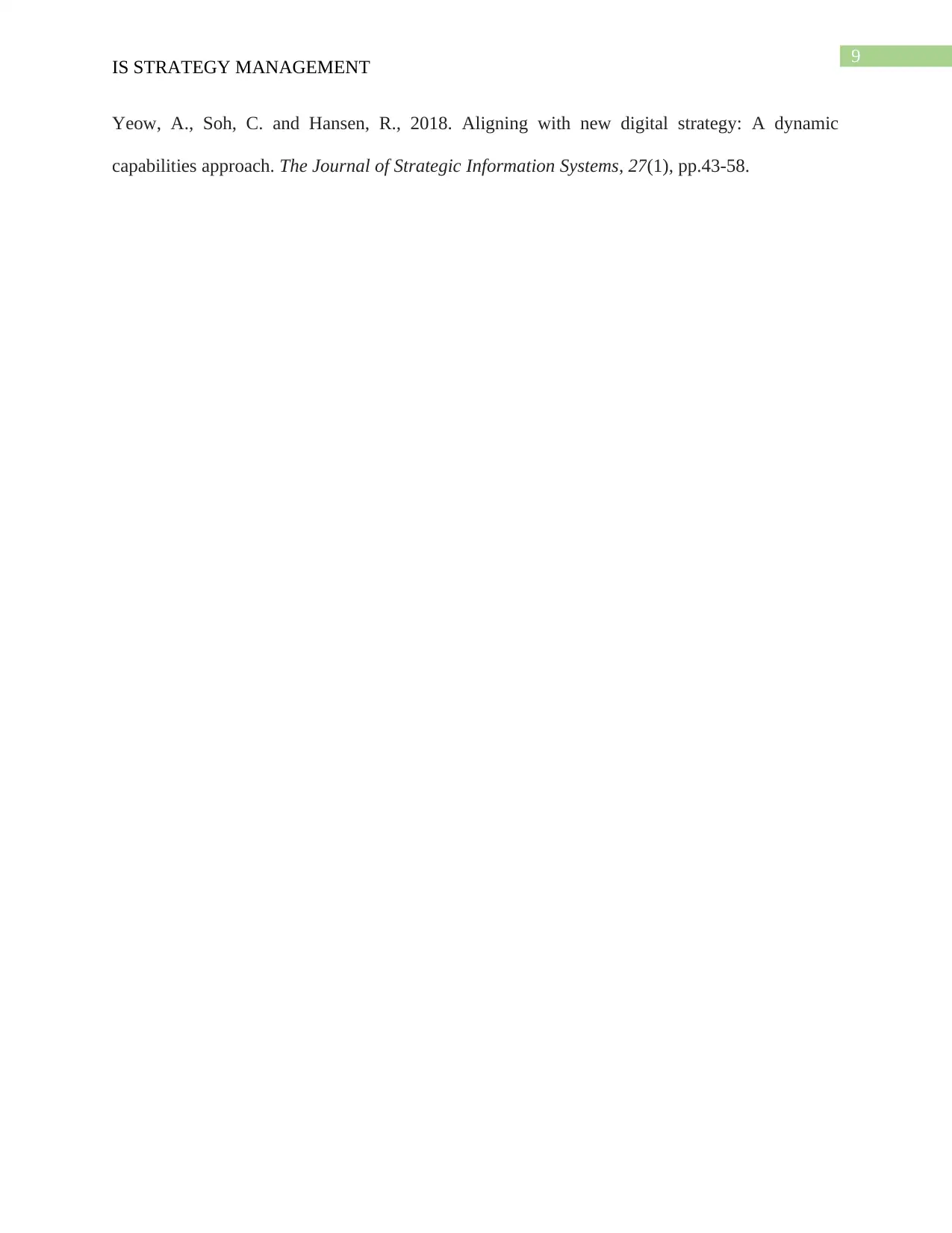
9
IS STRATEGY MANAGEMENT
Yeow, A., Soh, C. and Hansen, R., 2018. Aligning with new digital strategy: A dynamic
capabilities approach. The Journal of Strategic Information Systems, 27(1), pp.43-58.
IS STRATEGY MANAGEMENT
Yeow, A., Soh, C. and Hansen, R., 2018. Aligning with new digital strategy: A dynamic
capabilities approach. The Journal of Strategic Information Systems, 27(1), pp.43-58.
1 out of 10
Related Documents
Your All-in-One AI-Powered Toolkit for Academic Success.
+13062052269
info@desklib.com
Available 24*7 on WhatsApp / Email
![[object Object]](/_next/static/media/star-bottom.7253800d.svg)
Unlock your academic potential
Copyright © 2020–2025 A2Z Services. All Rights Reserved. Developed and managed by ZUCOL.





